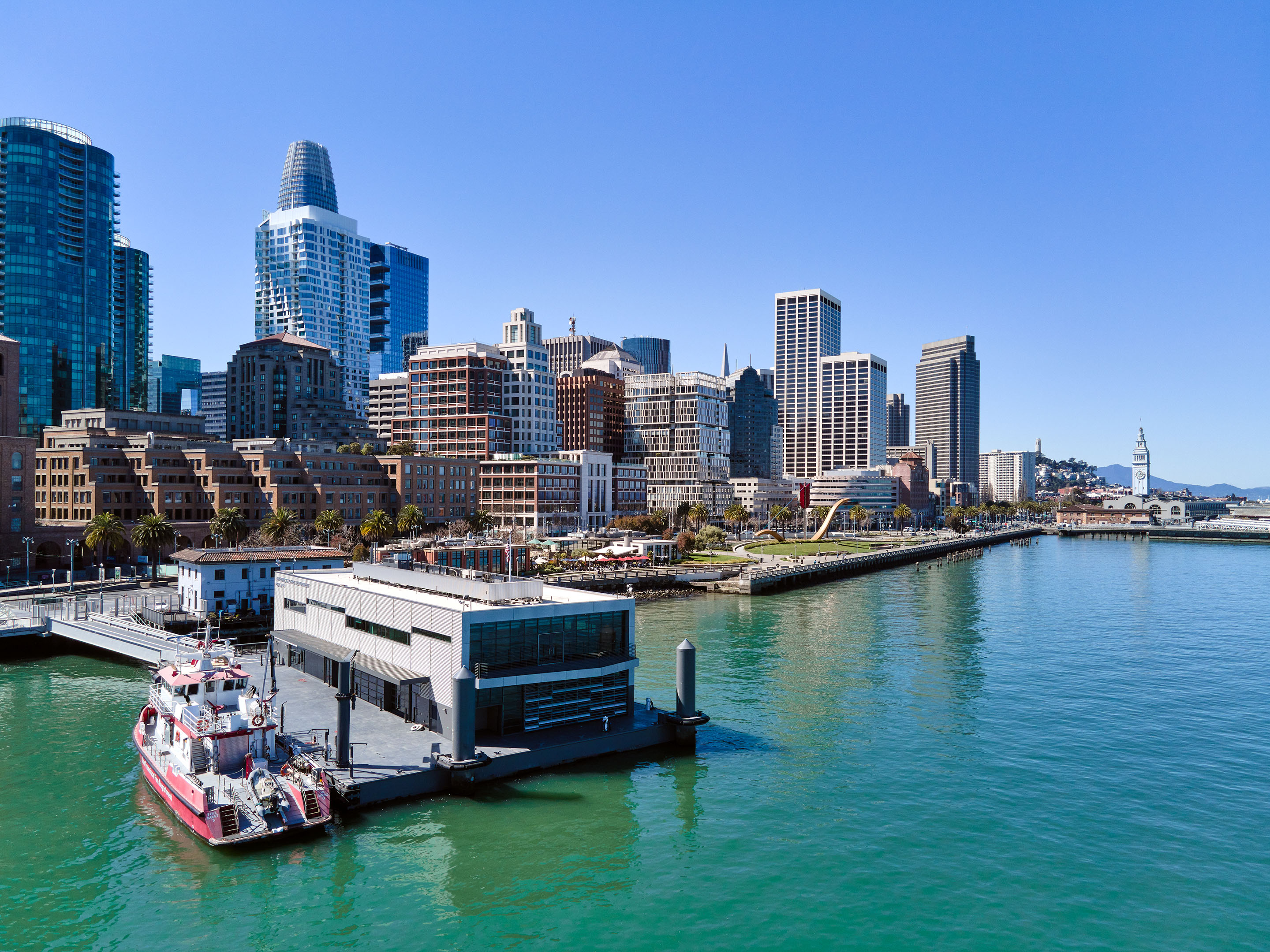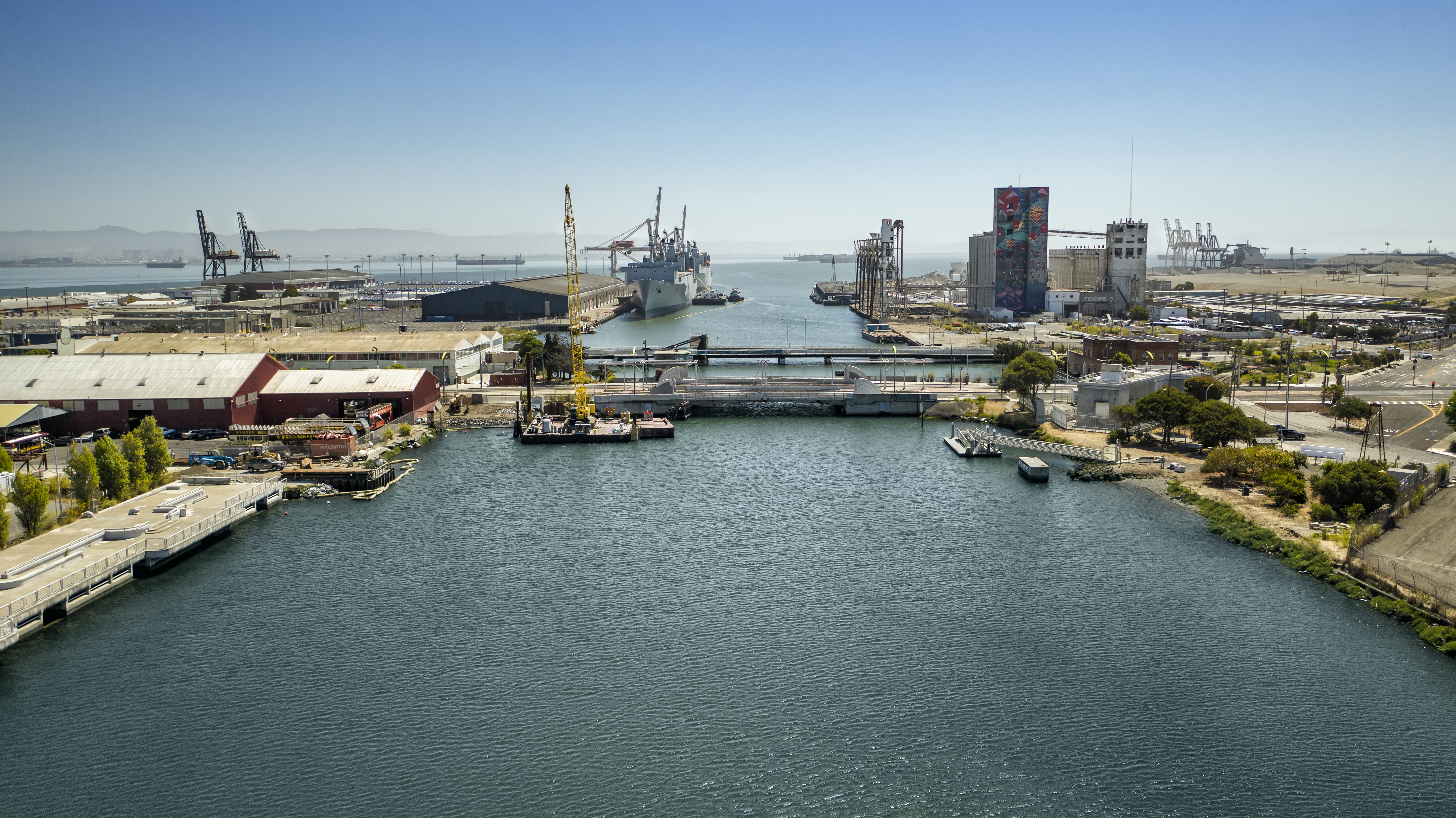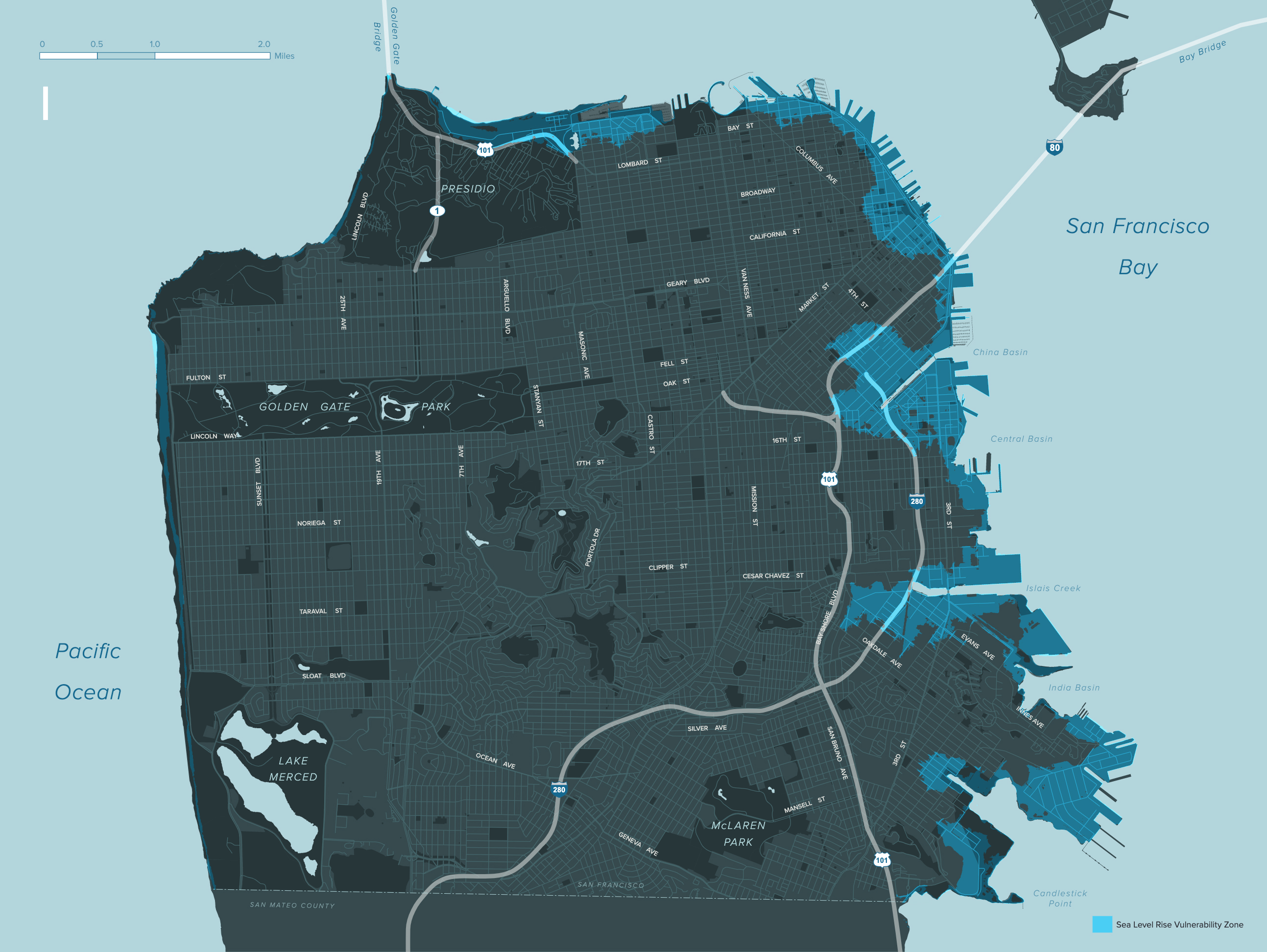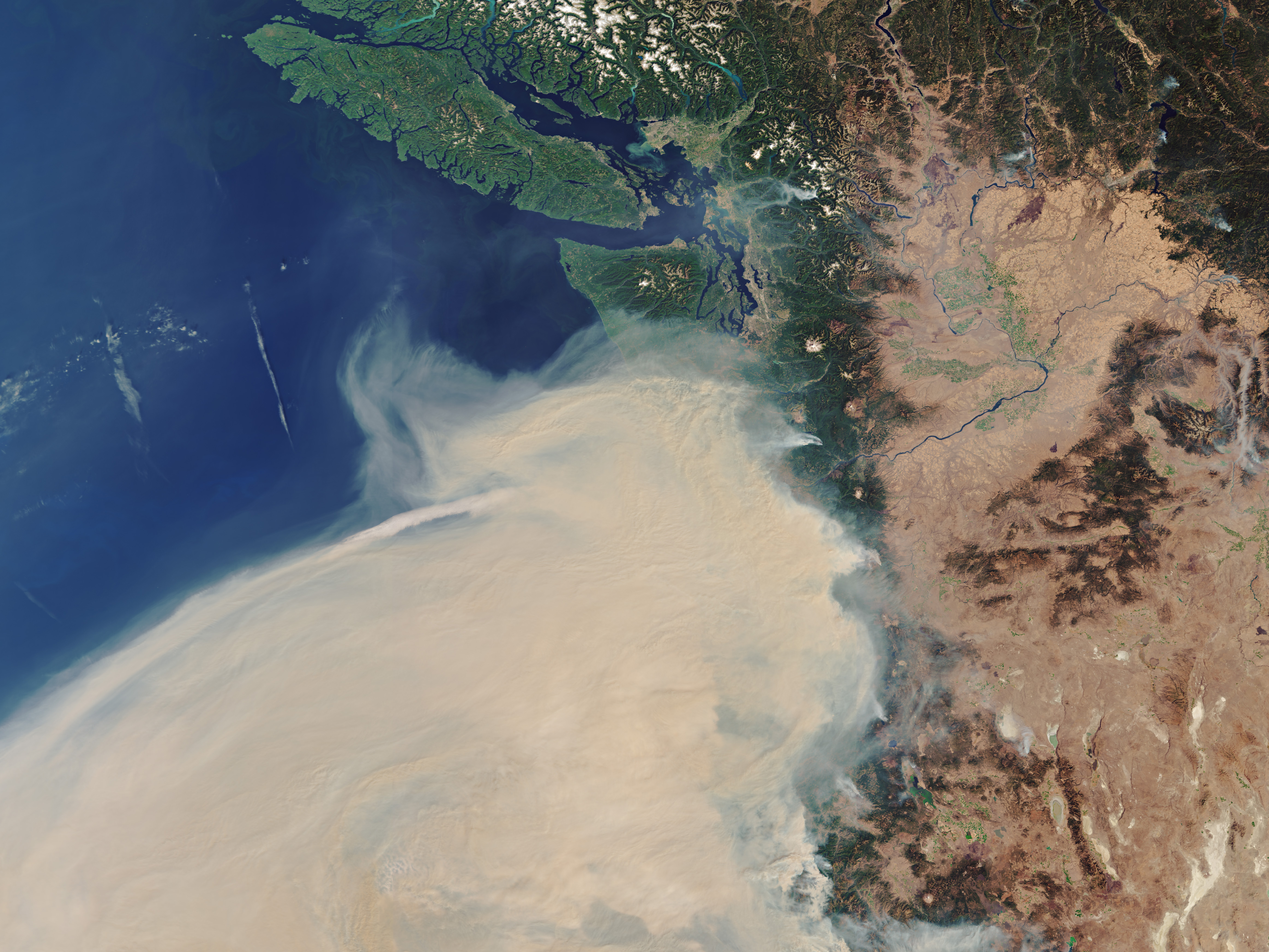Building a climate-resilient San Francisco requires both safeguarding against current and future climate hazards as well as eliminating and sequestering harmful greenhouse gas emissions. This section describes some of the key policies, plans, and projects that the City is taking to make San Francisco resilient to immediate and long-term threats of climate change and build a more equitable and sustainable city.

Getting to Net-Zero
Chapter 9 of the Environment Code codifies San Francisco’s emissions reductions goals of 61% below 1990 levels by 2030, and net zero emissions by 2040. The 2021 Climate Action Plan (CAP) is the City’s roadmap for meeting these emissions reduction goals. Preliminary estimates of the costs to implement the CAP from UC Berkeley’s Center for Law, Energy, and the Environment range from $2.3 - $21.9 billion. These estimates were purely for scoping purposes and costs could be much higher in the most capital-intensive sectors, like public transit. Some of this investment will come from the private sector, but a considerable amount of direct investment in the City’s own buildings and infrastructure will also be required. The Transportation & Land Use, Building Operations, and Energy Supply sectors of the CAP have the greatest need for capital investment. (Note: CAP Housing sector goals are reflected in the Affordable Housing chapter, and Healthy Ecosystems sector goals are discussed in the Adapting to Climate Change Impacts section, below).
Transportation and Land Use: The CAP goals for the Transportation and Land Use sector are for 80% of trips to be taken by low carbon modes by 2030, and for 25% of all registered vehicles to be electric by 2030. The Transportation and Land Use chapter of the CAP has seven strategies: transit, active transportation, pricing, parking, housing and jobs, land use, and electric vehicles. When implemented together, the strategies can both reduce emissions and generate community benefits such as, equity, public health, safety, and economic vitality.
First, one key to achieving these goals is building a fast and reliable transit system by implementing the recommendations of ConnectSF Transit Strategy and the Muni Forward Program. These plans include advancing major transit capital projects, including a new Westside Subway along 19th Avenue and Geary, the Caltrain Downtown Extension, Central Subway extension, and a Second Transbay Crossing. Another critical strategy is the implementation of the “Five-Minute Network”, or the infrastructure required to have service every 5 minutes or better on core transit corridors. This involves implementing transit priority treatments on frequent corridors to ensure transit is not delayed by congestion. Finally, investing in good state of repair is also critical to improving transit reliability.
Second, a complete transportation network that shifts trips from automobiles to walking, biking, and other active forms is also needed to meet the CAP’s goals. This involves expanding the bikeway network including protected bicycle lanes, Slow Streets, and bicycle parking, and programs that make corridors attractive for all demographics, including increasing transportation options at transit stops. These programs also support the City’s Vision Zero goals of eliminating traffic fatalities.
Third, where motor vehicle travel is necessary, expanding publicly available electric vehicle charging infrastructure is critical to advance the adoption of zero-emissions vehicles. This includes investment in electric vehicle charging in municipally-owned parking garages, evaluating curbside pilots, and building infrastructure that allows for zero-emission delivery, drayage, and longer haul trucks to support the deliveries that small and locally owned businesses need to make.
For more detail on planned and deferred transit and transportation network investments, see the Transportation Chapter.
In addition to investment in the physical transportation network, key policy changes will be needed to reach the goals while also correcting the inequities of past investments. This includes pricing and financing mobility to reflect the true costs of carbon intensive systems including implementing recommendations of the Downtown San Francisco Congestion Pricing Study, and various parking reforms that prioritize safety, efficiency, and equity.
Building Operations: In the building sector, the CAP established zero-emission targets for large commercial buildings by 2035, and all buildings by 2040. A key strategy to achieve this goal is to replace natural gas equipment with efficient and all-electric equipment. Achieving this mostly relies on investment by private building owners, but large investments in City-owned facilities will also be required. Additional funds to support low-income residents and residential building types that receive public funding subsidies, such as deed-restricted affordable and supportive housing, will be needed as well.
Chapter 7 of the Environment Code advances environmental goals in municipal buildings and is being updated to address the City’s CAP and net-zero carbon goals. One of the substantive proposed updates to Chapter 7 relates to the electrification of existing building systems. As natural gas equipment is retired, it will be replaced with electric equipment. Doing so will require electric service infrastructure upgrades as well as significant building modifications to accommodate the new loads and equipment. The City is currently working on an inventory of all-natural gas equipment.
The costs associated with electric infrastructure upgrades (e.g., PG&E interconnection issues; upgrade to primary service; new main switchgear, panelboard, and/or transformer; trenching; design and reconstruction work, etc.) for municipal electrical retrofits will be substantial. According to the San Francisco Public Utilities Commission (PUC), interconnection costs alone are expected to range between $300,000 and $2.5 million. According to PUC, customers should also budget a minimum of approximately $800,000 for primary switchgear where needed. Costs for trenching, and other equipment will vary based on existing circuit capacity and proximity to the point of connection. Overall, the costs to upgrade municipal buildings from gas to electric are likely to exceed $500 million.
Proposed updates to Chapter 7 also require implementing solar and solar storage capabilities at Critical Community Institutions to provide emergency power without the need for gas-powered generators. The requirement applies to new construction, HVAC replacement, or electrical update at buildings necessary for providing vital societal and individuals functions including public safety facilities, health clinics, community centers, libraries, and emergency management facilities. These new regulations will help the City prepare for and recover from energy disruptions with the minimum use of additional fossil fuels.
To ease the transition to all-electric buildings in an equitable way for the residential sector, the San Francisco Department of Environment (SFE) along with critical community stakeholders are creating a Climate Equity Hub (the “Hub”). The strategic priorities of the Hub will be to (1) channel resources and support to owners and renters to increase the demand for electrification retrofits; (2) support the equitable growth of the industry and workforce to ensure the workforce can satisfy demand, and (3) inform and streamline permitting requirements to decrease barriers to electrification.
Energy Supply: The CAP goals sets a goal to achieve 100% renewable electricity by 2025, and 100% renewable energy by 2040 (meaning no fossil fuels). A key strategy to achieve this is to provide 100% renewable electricity at affordable rates which will then facilitate the decarbonization of buildings and transportation.
The CAP calls for a “decarbonization master plan,” which would map out strategic decommissioning of the natural gas system to accompany electrification efforts. The master plan would also aim to protect low-income ratepayers during this transition. Customers who cannot afford to make the switch to electrification in the near-term could be penalized by the fixed costs to maintain natural gas distribution infrastructure. The master plan would address these costs to prevent undue financial burden. The city must engage in efforts initiated by the California Public Utilities Commission (CPUC) and confer with businesses, residents, state regulators, and energy providers to develop a local approach that is informed by data, constraints, and opportunities to ensure equitable energy cost outcomes.

Achieving the CAP’s energy supply goals also requires investment in distribution infrastructure, including acquisition of PG&E’s assets serving the city, to provide clean, reliable and affordable electricity throughout the city while also taking meaningful climate action. Fully controlling electrical delivery would also allow San Francisco to advance equity in electric service and workforce development. The City and County submitted a petition with the CPUC requesting a formal determination of the value of PG&E’s local electric infrastructure, the next step in San Francisco’s efforts to acquire the utility’s city-based electric facilities and complete the transition to public power. The request comes after the City made a $2.5 billion offer in 2019 and again in 2020 to purchase PG&E’s local electric assets.
Adapting to Climate Change Impacts
The 2020 Hazards and Climate Resilience Plan is the City’s roadmap for making San Francisco’s people, buildings, and infrastructure more resilient to climate hazards that are becoming increasingly severe and frequent. This section highlights some of the plans and projects that address the risks associated with sea level rise, flooding, extreme heat, and poor air quality.
Sea level rise and flooding: San Francisco faces coastal flood risks today. These risks will increase in the future as sea levels and shallow groundwater rise and extreme storms become more frequent, threatening buildings, small businesses, popular attractions and open spaces, jobs, and critical services such as BART, Muni, and the wastewater system. To defend San Francisco from current and future flood risks, the shoreline needs to adapt to address up to seven feet of sea level rise that is projected by 2100. Any effort aimed at long-term sea level rise resilience should also strengthen the waterfront against the urgent earthquake risk the city faces.

The Port of San Francisco’s Waterfront Resilience Program works to ensure the waterfront, and its critical regional and citywide assets, are resilient to hazards; and concomitantly increasing the accessibility of the waterfront. The City has a once-in-a-generation opportunity to defend the City’s waterfront from future flood and earthquake risks, and to improve and rejuvenate the waterfront, improve the City’s connection to the San Francisco Bay, and bring benefits such as more open space, enhanced mobility, safety, and jobs.
The U.S. Army Corps of Engineers and the Port have partnered on the San Francisco Waterfront Coastal Flood Study to study the costs and benefits of building flood defense infrastructure along the San Francisco shoreline from Heron’s Head to Fisherman’s Wharf. The preferred strategy from the Flood Study will be presented to Congress for billions of dollars in possible federal funding.
Early projects on the Embarcadero address the areas most vulnerable to earthquake and sea level rise along the waterfront. They are near-term actions, focused on improving life safety and City-wide disaster response capabilities and are the first step toward building long-term resilience. The Port has identified 23 early projects based on its extensive risk assessment work. The Port is recommending 16 Embarcadero Early Projects to advance through the voter-approved 2018 Embarcadero Seawall Earthquake Safety Bond Program, with plans to advance the remaining projects through other funding sources and partnerships.
The City, led by the Planning Department, the Municipal Transportation Agency, the Port, and the PUC, recently completed the California Department of Transportation (Caltrans) Senate Bill 1-funded Islais Creek Southeast Mobility Adaptation Strategy that developed a long-range vision for the Islais Creek shoreline and surrounding neighborhood. The vision includes phased adaptation actions to protect transportation infrastructure, enhance shoreline access and habitat, nurture community resiliency in adjoining neighborhoods, and support sustainable industrial jobs. The strategy identified implementable near- and mid-term investments to advance long-term adaptation toward that vision.
The Islais Creek Bridge rehabilitation project incorporated sea level rise adaptation into its design. Structural deficiencies, such as deteriorated girders and deck, were noted during a Caltrans inspection and rehabilitation of the bridge began in 2013. Sea level rise projections showed accelerated impacts, so the Department of Public Works engaged other departments in a charette that resulted in a proposal with raised approaches, including changing the existing superstructure to a concrete fixed-span bridge at a higher elevation. The proposed design has several benefits, including lower construction costs and downtime for light rail, lower maintenance costs, improved seismic resiliency, and improved reliability for transit and traffic crossing. Finally, the design aligns with a federal funding program, potentially saving the City $30 to $50 million.
A number of City, state, and federal agencies are working on various efforts at Ocean Beach to adapt to climate change and coastal erosion. Projects will change the roadway south of Sloat Boulevard, modify public access, alter coastal management, and prepare Ocean Beach for a changing climate. Erosion is expected to worsen with sea level rise, further threatening roads and sewers, and causing the beach to narrow. Agencies are working together with beach users and community members to adapt to these coastal changes and protect critical infrastructure while supporting open space, recreation, and natural habitat.
In addition to planning for sea level rise, San Francisco is planning for stormwater flooding. The City recently completed an Extreme Precipitation Study, developed by Pathways Climate Institute and Lawrence Berkeley National Laboratory (LBNL), to help San Francisco prepare. Initial modeling demonstrates that storms are likely to get more intense and severe as the climate warms. The models projected an increase in storm duration, ranging from 9 – 24% increase in duration by 2050 and from 18 – 55% increase in max duration by the end of century, both relative to historic conditions. Since the combined sewer system was not designed to handle that size of storm, future plans will need to consider a range of adaptation measures to reduce flood risk.
Extreme heat and poor air quality As extreme heat and wildfire smoke events become more frequent and more extreme, increasing access to resilient buildings and infrastructure can protect San Franciscans from health impacts of these climate change-fueled hazards. Additionally, as evidenced by recent extreme heat events such as the 2021 Western North American Heat Wave, extreme heat can affect infrastructure systems, such as roads and railways buckling from the heat and the electrical grid straining under increased power use. Adaptation of buildings and infrastructure is critical for protecting the health and wellness of San Franciscans, and for ensuring continuity of operations during hazards.
The Heat and Air Quality Resilience Project (HAQR) is a cross-sectional initiative to identify, plan, and implement comprehensive medium-to-long-term extreme heat and wildfire smoke strategies. HAQR has a particular focus on the resilience of disproportionately impacted frontline and BIPOC communities. This is achieved by creating new strategies, increasing pre-event collaboration between institutional actors, advancing equity and efficacy during strategy implementation, and pursuing funding for these initiatives.
A particular focus of HAQR is to support extreme heat and air quality adaptations to the City’s public and private building stock, with an emphasis on buildings that house the populations most vulnerable to the health impacts of extreme heat and wildfire smoke. HAQR offers an opportunity to elevate extreme heat and wildfire smoke as a building rehabilitation goal, identify new funding streams, and identify best practices. Examples of this can be seen in the pursuit of pilot projects in the affordable and permanent supportive housing, as well as existing weatherization and resilience improvements to City facilities such as the MERV-13 HVAC improvements to 49 South Van Ness, improvements to Kezar Pavilion, with major resilience renovations to Mission and Chinatown Branch Libraries.
HAQR will also support the expansion of green infrastructure city-wide, targeting urban heat islands and neighborhoods with the greatest heat health burdens. These nature-based solutions will increase equitable outcomes for neighborhood residents, and align with the CAP’s residential carbon sequestration objectives. HAQR’s mapping efforts inform locations for these future greening projects.

Photo Credit: Copernicus Sentinel (2020)
processed by ESA

